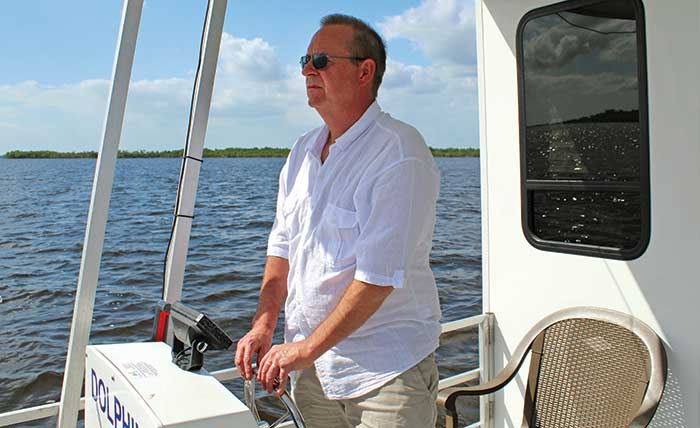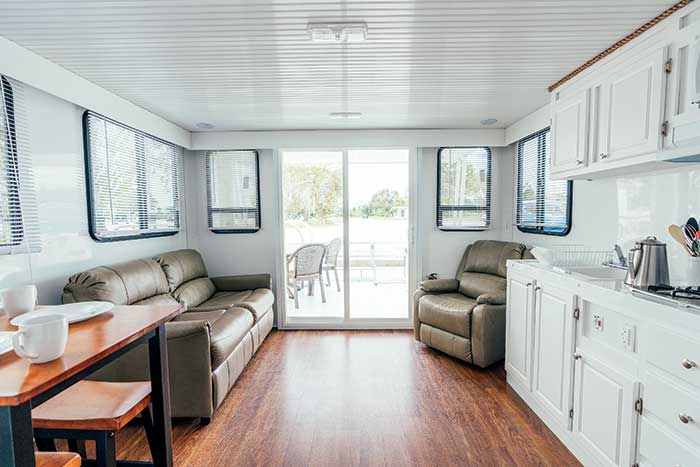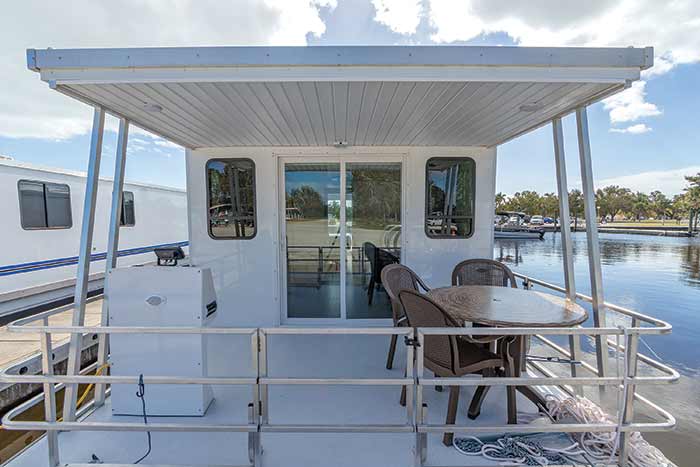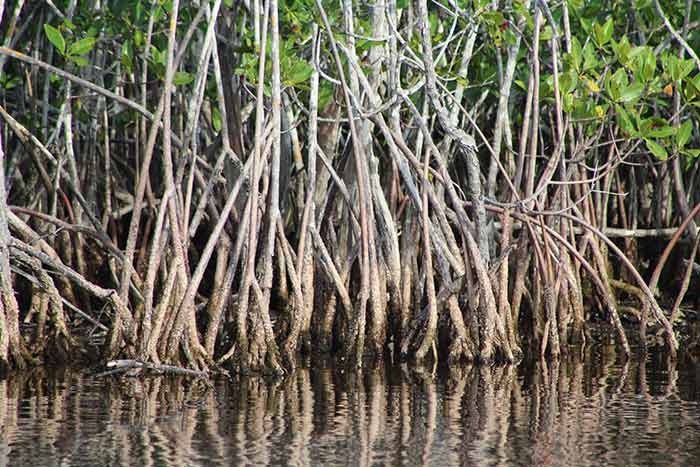Advertisement
As a nature lover, the thought of renting a houseboat in the Florida Everglades certainly had appeal — a rare chance to see exotic birds, sea turtles, and manatees up close. On the other hand, the notion of being dropped off at some anchored hotel room in the middle of gator country had me feeling less like a naturalist, and more like bait. That is, until I learned I could drive the houseboat around and anchor pretty much wherever I liked. Now this was a boating trip ... of a different kind.
Flamingo Adventures kindly offered me a chance to see for myself with few nights on a houseboat to explore Whitewater Bay, the largest body of open water in the 1.5 million acres of wetlands that make up Everglades National Park, located on the southern tip of Florida. Flamingo Adventures has a 20-year contract with the federal government to provide guest services to park visitors. You have to pay the $30 National Park pass (good for seven days), then drive 38 miles to reach the low-key Flamingo Marina in the middle of nowhere — but is still somehow only a 90-minute drive from Miami. The marina store rents canoes, kayaks, bikes, skiffs, and pontoon boats — as well as four houseboats. The white, fiberglass, 42-foot shoebox-shaped houseboats sit on twin pontoon hulls and weigh 8,000 pounds. They are powered by a single 115-hp Yamaha outboard. Ours was named Dolphin. My wife, Rhiannon, graciously accepted my offer for the first mate and chief photographer gigs.
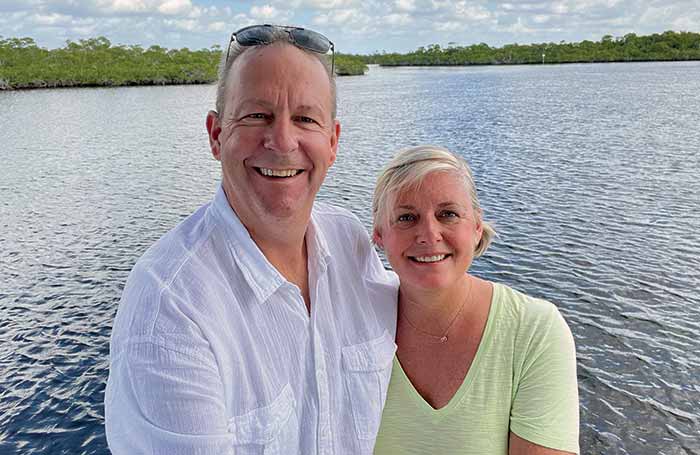
The author and his wife, Rhiannon, avid runabout dayboaters, discovered a different kind of boating serenity in this one-of-a-kind playground.
Into The Wild
As with most charter or rental operations, a staff member pilots the boat out to the drop-off point and back to its slip. Departing from Flamingo Marina, Capt. Chris rattled off Everglades navigation tips mixed with local knowledge, such as how we can identify the world's most poisonous plant, why this is the only place on earth with both alligators and crocodiles, and to listen at night for "a bird that sounds like a drunken monkey."
Our 20 minutes of no-wake motoring through Buttonwood Canal, across 1.5-mile Coot Bay, then through curved, mangrove-lined Tarpon Creek, suddenly opened up wide to vast Whitewater Bay, 10- by 6 miles, and home to countless little hideaways for angling or anchoring. The "islands" ahead have no land; they're made entirely of dense tangles of mangroves and their "prop roots" that grow out of the trunk and branches, then down to the water, making the trees appear to be standing on their roots above the water. This part of the Everglades has a controlling depth of about 3-1/2 feet, plenty for the 2-foot draft of our pontoon boat.

Here is where Capt. Chris wished us luck and stepped onto a chase boat. It was late afternoon, and the boats must be anchored by dark, so our priority was finding a lee from the 10-knot northerly breeze. "The Joe River is a good bet," Capt. Chris said. "Meet me back here at 10 a.m. Tuesday."
I took my seat behind the modest helm station, a pedestal mounted to the starboard foredeck. I had a GPS chartplotter with various past runs available to follow, VHF radio (Ch. 18 for base), and a depth sounder, so getting lost was not a concern.
Getting the sense for maneuvering what feels like an extended cab box truck with no side mirrors, I throttled up into open water and was surprised to be quickly making way at 5 mph. My first thought was how well the boat turned. It certainly wasn't a tight radius, but I could loop around and catch my own wake in about 10 seconds, and I was impressed with my slow-motion serpentine course. "This is so easy," I said out loud.
Tip
Emboldened with confidence, I turned to port and headed west into Joe's wide mouth, which quickly narrows and winds through a maze of mangroves with out-of-the-way pockets to anchor around most every bend. We passed just one other houseboat boat (a mom and daughter fishing off the bow, casting toward the mangroves) during our hour-long meander to some lee shore we'd know when we found it. I caught a glimpse of a dolphin 20 feet ahead, missed my chance at a photo, but found our spot.
Step Aboard
They may not impress from the exterior, but step inside one of Flamingo Adventures' houseboats, and any fears of residing in a glorified fish shack are immediately dispensed. The interiors are nice, simply appointed in terms of furniture, but with every comfort of a small apartment.
The departure is made simple because the refrigerator and hot water automatically switch from shore power (electric) to propane once the boat leaves the dock. Working back from the bow, the galley includes a gas range, gas-electric refrigerator with a freezer, microwave, small coffee maker with filters, and a basic set of cooking utensils, glasses, dishes, silverware, pots/pans. The area also includes a loveseat and a small table with chairs.
A narrow passageway has a full-size bed opposite a full bath (sorry, no tub). The main stateroom takes up the entire enclosed aft section. Our boat had a TV mounted for connecting to a device. Heavy curtains did a good job of blocking out light. Two seats, a propane grill, and fish-cutting table (both mounted to the back rail) fill up the smaller aft deck.
Flamingo Adventures says the houseboats can sleep six, but the narrowness essential for the design seemed to us that four people is plenty and would work best with family or close friends.
Houseboats are equipped with a 12-gallon main running tank and three 6-gallon spare tanks, for total of 30 gallons of gas. With just the two of us aboard for two nights, we still had about 25 of the 70 gallons of fresh water (showering as if at home). Leaning heavy on the generator, we used up two of the three cans of spare gas. Our only fee on the way out was about $90 for a 19-gallon refill.
Pricing starts at $300 (for two-night minimum). Tourist season in the Everglades is the "dry season," from early December to April. You'll get more pleasant temperatures, fewer mosquitos, and a higher probability of spotting wildlife. The Flamingo Lodge & Restaurant, which will include rooms with amenities and a restaurant/bar, is scheduled to open later this year. Visit FlamingoEverglades.com to learn more.
Setting Up For The Night
Our boat had two anchors: a 33-pound claw and a 9-pound Danforth. After working up a sweat wrestling to pry the claw from the muck and over the rail the first morning, I opted for the mercifully lighter Danforth for any anchoring other than overnight. It dug right in and was easy to retrieve.
Breezes were consistent and mild, which made for refreshing airflow when anchored with the bow and stern sliding doors open. I grilled chicken on the propane grill to top the salad Rhi made in the galley. We ate on the aft deck to take in the radiant sunset, looking out across Whitewater Bay and eating in silence, both savoring a good meal in paradise. I've seen sunsets and sunrises before, but this one felt like we had front-row seats at our own private show. That's when I realized this wasn't so much a "doing" vacation as a "being" holiday. Just being present in this peaceful world felt like medicine for the soul.
How Are The Mosquitos?
Everglades mosquitos may appear benevolent in giving you the time to savor a glorious sunset — but not a moment more. When the last orangey sliver of sun slips behind the mangroves, the mosquitos don't wait for applause to storm the stage. And since warmblooded mammals are in short supply in the 'Glades, humans are the main course.
We were given two bits of advice: "Bring the strongest bug spray you can," and, "If you wait an hour after sunset, the swarm isn't so bad." We opted to let the mosquitoes work their night shift and never bothered to test the latter tip.
Packing List
- Bug spray
- Jacket (it can get chilly at night)
- Polarized sunglasses
- Earplugs (to block out generator)
- Gloves (to handle the anchor)
- Binoculars
- Camera with zoom lens and tripod
- A good book
- Movies and shows downloaded on a smart device
Good Morning!
The sun was our alarm clock, and our simple morning ritual brought yet another reward. The coffee maker was set in motion, then I took a quick look outside to make sure we were in the same spot and scanned for the first outline of orange to appear. Within minutes, we had scrambled eggs, toast, fruit, coffee, and orange juice on the bow deck table. With a building chorus of bird calls as our soundtrack, we ate while transfixed by this astronomical event that happens every day of our lives but rarely gets our undivided attention.
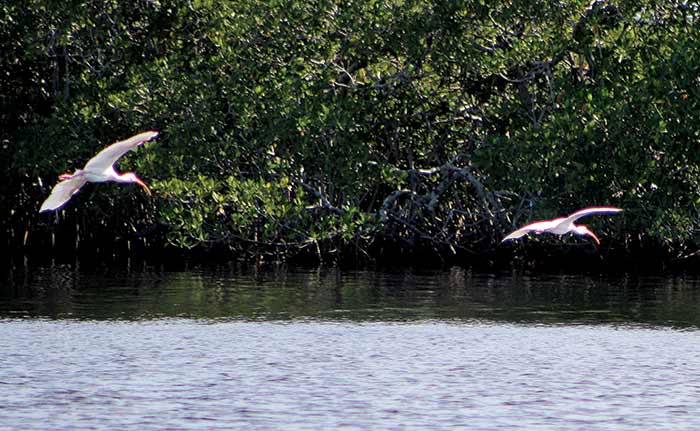
The American white ibis is one of more than 386 species of birds that make their home in Everglades National Park.
This would be our only full day aboard, so we decided to meander, starting by chugging across Whitewater Bay. I couldn't be happier. The bay is so open across 3 miles, it feels like running on a quiet lake. The only other action was the occasional center-console zipping anglers to one of the many hot spots in one of the best fishing locations in the world. They seem to come from nowhere, then they're gone in a flash, clearly focused on one pursuit.
I was focused on seeing how fast I could comfortably cruise a 42-foot houseboat. I soon settled on 5 knots in open water (with a 7- to 10 mph breeze and nearly a foot of chop) because the boat told me when I was going too fast when our foredeck was washed. On that day, 8 mph was too fast. No harm, no foul, and 5 mph felt just fine.
Everglades Houseboating Is Great For:
- Fishing buddies who use a houseboat as a base camp, then take off in their small center-consoles for a day of fishing.
- Families, but not toddlers. Even young kids may wonder why they can't go in the water. As parents, we thought the houseboat would work fine with babies or kids 8 years and older.
- Taking out elderly or limited-mobility boating friends and family. Even at its worst, running speed is gentle on the back and joints.
- An adventurous honeymooning couple on a budget.
- The harried family. If you're coming off an action-packed family vacation (say, at Disney in Orlando), a few nights on a houseboat could be the perfect vacation from your vacation.
How'd You Sleep?
We live in a city, so we're used to sleeping with noise. But unless you've slept with a generator humming continuously though the night, you'll have a few decisions to make. My wife opted for air conditioning on and earplugs. But the generator is set up on the other end of the boat from the main stateroom that has a real door to close. That muffled the sound enough for me. All of the windows are screened, so no AC is another option.
Our Generac Q3500 had an electric start that worked immediately, and a 2.6-gallon fuel tank that has a rated run time of nearly nine hours at half load. I don't know what our load was, but with the AC cranking, the generator I started at 5:30 p.m. lasted until 1:30 a.m. Despite being willing to sacrifice blood to the mosquitos to get the Generac filled and fired up again, the cool lasted until morning and we both slept deeply. Of course, that didn't prevent a midday escape from the sun to the queen bed for some snoozing with an open-door breeze and the sound of water gently lapping on the aluminum hulls.
Takeaways From Paradise
After two nights aboard, my wife and I agreed a third would have been better. After all, this was our first experience getting a spectacular sunrise and sunset in the same day. On our final morning, we woke to both a radiant orange sunrise and a white waning Gibbous moon still hanging high in the now blue sky!
Tip
It's easy to fall into nature's rhythm on an Everglades houseboat. I kept my Canon DSLR with zoom lens always nearby, but this isn't a Disney ride with automated creatures that rise up on cue. If I was unlikely to capture some award-winning wildlife photo, then I was quite content to sit, watch, and listen. Sunsets delivered orange-streaked skies. The birds we'd seen flick about the mangroves, hunting for food, gathered into large flocks that flew overhead, bound for their nests.
The quieting birds gave way to the gentle sound of water gurgling against the hulls in the dying light. "Hypnotic" is good way to describe the experience. The black nights bring a calming silence, and the mornings feel like opening a new present.
"I could just sit here all day," my wife declared, raising her coffee mug to the rising sun. For whatever reason, that Café Bustelo coffee we bought sure did taste good. Maybe the best in my life.
Fishing The 'Glades
One third of Everglades National Park is covered by water. Snapper, sea trout, redfish, bass, and bluegill are plentiful. Freshwater and saltwater fishing require separate Florida fishing licenses.
As for bait, live or dead fish (including minnows and shiners) or amphibians, and nonpreserved fish eggs or roe are prohibited. Digging for bait inside the park is not permitted.
Licensed anglers are limited to possession of 20 fish per person at any time, but may possess no more than 10 fish of any one species. There is no possession limit for nonnative species.
All anglers are urged to pick up a current copy of the Everglades Fishing Regulations available at all visitor centers and entrance stations.
— National Park Service


